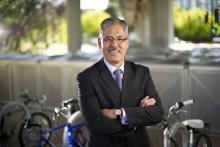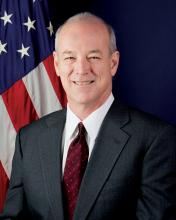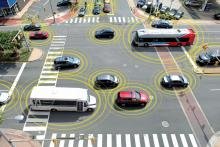Jon Masters looks at the USDOT’s new ITS Strategic Plan for the next five years. Emphasis and direction for the next five years of Government led ITS research in the United States has been framed within a new ITS Strategic Plan. The US Department for Transportation’s (USDOT) ITS Joint Program Office (JPO) published the report at the tail end of 2014 after concluding a two-year ITS industry consultation process. The Plan identifies a vision to transform the way society moves and the ITS JPO’s aim of advancin

Aggregate level of emphasis on connected vehicle research
Jon Masters looks at the USDOT’s new ITS Strategic Plan for the next five years.
Emphasis and direction for the next five years of Government led ITS research in the United States has been framed within a new ITS Strategic Plan. The US Department for Transportation’s (USDOT) ITS Joint Program Office (JPO) published the report at the tail end of 2014 after concluding a two-year ITS industry consultation process.
The Plan identifies a vision to transform the way society moves and the781 ITS JPO’s aim of advancing research on realising connected vehicle (CV) implementation and advancing automation. It builds on the progress made in design, testing and planning for CV deployment, shapes the ITS Program’s research and development going forward and reflects where the bulk of transportation research and innovation is heading.
Also included is a comprehensive structure that can be used to develop actionable goals, program milestones and timelines and outcome measures to determine success.
Around 700 contributors representing nearly 300 different organisations helped shape the Strategic Plan for 2015-19, says
USDOT’s ITS JPO director Ken Leonard. The plan does not attempt to cover all ITS in the US. “There are other areas where we’re seeing tremendous private sector input and work of other authorities that we don’t get involved in,” Leonard says.
Nonetheless, the Strategic Plan sets out the direction of ITS development to be sponsored at a Federal level by roughly $100 million of annual JPO research funding, says Leonard. Essentially it continues the general momentum of ITS development in the US, with particular focus on Connected Vehicle (CV) and Automation programs. “Our main goal is to achieve a period of development as successful as that associated with the last ITS JPO plan,” said Leonard.
“With regard to CV development, a lot has been done over the past decade. It’s accelerated over the past year alone, including a legislative announcement on rule making. A lot has come to a head and now we want to tie up what has become a very large body of research, get some things finished and help create an environment for automated vehicles, and get CV into production.”
The majority of the JPO ITS sponsored research will concern pushing CV closer to implementation, and continuing with the early stages of investigating the impacts and possibilities of vehicle automation.
Randy Iwasaki, executive director of the7945 Contra Costa Transportation Authority (CCTA) in California, says: “I generally like the direction of the new JPO Strategic Plan. It mirrors a lot of what we’re trying to do at a local level. ITS development is usually geared to State-wide transportation needs, but a lot of decision-making, in California at least, is coming down to a more local level as we try to improve the situation on county roads.”
Iwasaki formerly worked for3879 Caltrans, which is well known for its technological research and CCTA is doing similar at a county level with a series of ITS program partnerships.
CCTA has established a large test-bed for CV and automated vehicle (AV) technology on a former US Navy weapons site in the city of Concord. This has been done in partnership with the US Navy,1685 Mercedes Benz Research & Development and the city’s authorities.
“We wanted to create a hub of innovation, as well as find a use for the Navy site. We see development of CV and AV as beneficial for the disadvantaged; improving mobility for all and for creating jobs,” Iwasaki says. “We may be relatively small, but we’re a nimble organisation. We were able to move quickly to set up agreement with the Navy.”
According to Iwasaki, just the signing of a non-disclosure agreement between the California Department of Motor Vehicles and the vehicle OEMs is now needed before the CV and AV testing can start in earnest.
“Contra Costa is an area where a lot of people want to live, but then commute out every day. We want to keep more of them here by creating an innovation hub, hence the CV and AV test bed.
“The ITS Strategic Plan will help us when reporting to the CCTA board. It validates the direction we’re going in and it makes bidding for funding that bit easier. We’re reliant on being able to do some of the Federal funded development work for them,” Iwasaki adds.
7477 Idaho Transportation Department (ITD) mobility services engineer Bob Koeberlein.
The ITD has begun work on an initial CV project in partnership with the Idaho National Laboratory, the universities of Idaho and Missouri, plus the weather sensor specialist144 Vaisala and others. The project has a number of goals, including development of enhanced road weather and large animal alerts and advancement of CV technology.
“The long-term view is of a gradual evolution from existing technologies to an entirely CV based environment, but this will take a long time. In the meantime, we have the opportunity to gradually migrate to better systems. We’ve started on that journey, but there is concern regarding standards,” says Koeberlein, who is also a member of AASHTO’s connected vehicle working group.
“We don’t have a certified and qualified products list for onboard DSRC (Dedicated Short Range Communications) equipment at present. A certification body would allow USDOT to establish an approved products list as new versions of DSRC radios are produced. And another hurdle to overcome is the security credentials of vehicle to infrastructure communication.”
A number of organisations including the electric vehicle manufacturer Tesla have raised concerns over the vulnerability of current security management systems and risk of a breach or security hack. “This is a big issue that needs to be sorted out,” Koeberlein says.
A further discussion at an AASHTO level has suggested equipping States’ vehicle fleets as early adopters of CV technology supported with Federal grant funding. “This would encourage more to get involved. There are fewer privacy concerns for State fleets, which also provide an easier adoption path as they are highly regulated. This appears an attractive way of getting the ball rolling on deployment,” says Koeberlein.
The JPO Strategic Plan is “good as far as it goes” as a high-level document, he adds, but it leaves a big space for discussion on how States are going to take deployment forward. “For example, perhaps a mentoring program would work, led by States with a head start on the CV program,” Koeberlein adds.
831 Federal Highway Administration is due to issue guidance for States on implementation of CV compatible infrastructure before the end of the current US financial year in September. The National Highway Traffic & Safety Administration has announced it will mandate CV in light vehicles, so is there a need to assist States that are not progressing CV programs?
“The great thing about our approach to CV is that vehicle to vehicle CV will work on its own without infrastructure developments,” Leonard says. “Vehicles and infrastructure are not on the same interdependent development track. As State DOTs do more, they will be able to realise more benefits for CV users and drivers not equipped with CV as traffic behaviour improves.
“We think significant safety and congestion benefits will become evident when just 5-7% of vehicles are equipped. Those States slower to adopt will not get as many benefits but the systems will still work. We’ve already done a lot of work on standardisation and we want to see networks interoperable across borders as well. The next step is to execute the operational elements of the Strategic Plan, starting with the award of tens of millions of dollars of further CV pilot contracts before the end of this financial year.”
Emphasis and direction for the next five years of Government led ITS research in the United States has been framed within a new ITS Strategic Plan. The US Department for Transportation’s (USDOT) ITS Joint Program Office (JPO) published the report at the tail end of 2014 after concluding a two-year ITS industry consultation process.
The Plan identifies a vision to transform the way society moves and the
Also included is a comprehensive structure that can be used to develop actionable goals, program milestones and timelines and outcome measures to determine success.
Around 700 contributors representing nearly 300 different organisations helped shape the Strategic Plan for 2015-19, says
USDOT’s ITS JPO director Ken Leonard. The plan does not attempt to cover all ITS in the US. “There are other areas where we’re seeing tremendous private sector input and work of other authorities that we don’t get involved in,” Leonard says.
Nonetheless, the Strategic Plan sets out the direction of ITS development to be sponsored at a Federal level by roughly $100 million of annual JPO research funding, says Leonard. Essentially it continues the general momentum of ITS development in the US, with particular focus on Connected Vehicle (CV) and Automation programs. “Our main goal is to achieve a period of development as successful as that associated with the last ITS JPO plan,” said Leonard.
“With regard to CV development, a lot has been done over the past decade. It’s accelerated over the past year alone, including a legislative announcement on rule making. A lot has come to a head and now we want to tie up what has become a very large body of research, get some things finished and help create an environment for automated vehicles, and get CV into production.”
In a nutshell
The Strategic Plan is based on six key program categories: Connected Vehicles; Automation; Emerging Capabilities; Enterprise Data; Interoperability; and Accelerating Deployment. To align the ITS plan with USDOT’s wider objectives and MAP-21 transportation funding, these have been set against a background of five themes: Safer vehicles and Roadways; Enhancing Mobility; Limiting Environmental Impacts; Promoting Innovation; and Supporting Transportation System Information Sharing.The majority of the JPO ITS sponsored research will concern pushing CV closer to implementation, and continuing with the early stages of investigating the impacts and possibilities of vehicle automation.
Randy Iwasaki, executive director of the
Iwasaki formerly worked for
CCTA has established a large test-bed for CV and automated vehicle (AV) technology on a former US Navy weapons site in the city of Concord. This has been done in partnership with the US Navy,
“We wanted to create a hub of innovation, as well as find a use for the Navy site. We see development of CV and AV as beneficial for the disadvantaged; improving mobility for all and for creating jobs,” Iwasaki says. “We may be relatively small, but we’re a nimble organisation. We were able to move quickly to set up agreement with the Navy.”
According to Iwasaki, just the signing of a non-disclosure agreement between the California Department of Motor Vehicles and the vehicle OEMs is now needed before the CV and AV testing can start in earnest.
“Contra Costa is an area where a lot of people want to live, but then commute out every day. We want to keep more of them here by creating an innovation hub, hence the CV and AV test bed.
“The ITS Strategic Plan will help us when reporting to the CCTA board. It validates the direction we’re going in and it makes bidding for funding that bit easier. We’re reliant on being able to do some of the Federal funded development work for them,” Iwasaki adds.
Gradual evolution
Other State authorities have a different view with regard to ITS development. In Idaho, for instance, State-wide ITS means deployment of electronic message signs, traffic management technology and remote weather stations. This is according toThe ITD has begun work on an initial CV project in partnership with the Idaho National Laboratory, the universities of Idaho and Missouri, plus the weather sensor specialist
“The long-term view is of a gradual evolution from existing technologies to an entirely CV based environment, but this will take a long time. In the meantime, we have the opportunity to gradually migrate to better systems. We’ve started on that journey, but there is concern regarding standards,” says Koeberlein, who is also a member of AASHTO’s connected vehicle working group.
“We don’t have a certified and qualified products list for onboard DSRC (Dedicated Short Range Communications) equipment at present. A certification body would allow USDOT to establish an approved products list as new versions of DSRC radios are produced. And another hurdle to overcome is the security credentials of vehicle to infrastructure communication.”
A number of organisations including the electric vehicle manufacturer Tesla have raised concerns over the vulnerability of current security management systems and risk of a breach or security hack. “This is a big issue that needs to be sorted out,” Koeberlein says.
A further discussion at an AASHTO level has suggested equipping States’ vehicle fleets as early adopters of CV technology supported with Federal grant funding. “This would encourage more to get involved. There are fewer privacy concerns for State fleets, which also provide an easier adoption path as they are highly regulated. This appears an attractive way of getting the ball rolling on deployment,” says Koeberlein.
The JPO Strategic Plan is “good as far as it goes” as a high-level document, he adds, but it leaves a big space for discussion on how States are going to take deployment forward. “For example, perhaps a mentoring program would work, led by States with a head start on the CV program,” Koeberlein adds.
Next steps
The“The great thing about our approach to CV is that vehicle to vehicle CV will work on its own without infrastructure developments,” Leonard says. “Vehicles and infrastructure are not on the same interdependent development track. As State DOTs do more, they will be able to realise more benefits for CV users and drivers not equipped with CV as traffic behaviour improves.
“We think significant safety and congestion benefits will become evident when just 5-7% of vehicles are equipped. Those States slower to adopt will not get as many benefits but the systems will still work. We’ve already done a lot of work on standardisation and we want to see networks interoperable across borders as well. The next step is to execute the operational elements of the Strategic Plan, starting with the award of tens of millions of dollars of further CV pilot contracts before the end of this financial year.”










